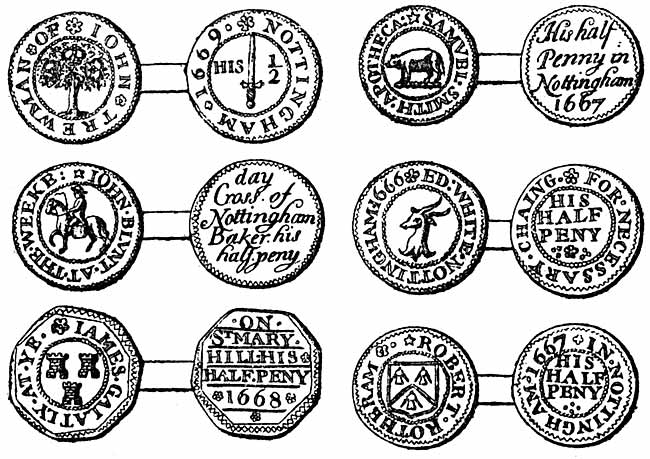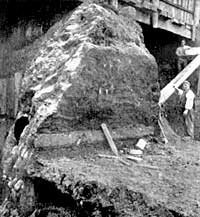TRADESMEN'S TOKENS.

Nottingham tradesmen's tokens.
Availing themselves of the privilege granted by the law to issue their own small tokens, between 1648 and 1672, about fifty-six were placed in circulation by Nottingham tradesmen; and about sixty-five were issued by others in different parts of the county. Among the Nottingham tradesmen who circulated halfpenny tokens was one John Blunt, who carried on the business of a baker, in Weekday Cross. He had two varieties of tokens. The striking feature of these was a representation of a man on horseback, with panniers. These bear no date, but give the name of the issuer, his occupation, address, and the value of the token. The two known varieties differ in style and quality of workmanship. One of them gives "Derross" instead of "Day Cross," and the other "Half-peny " instead of "Halfe-penny."'
BULL BAITING.
That the baiting of bulls was practised in the Weekday Market admits of no doubt. Various references to this degrading sport and the accessories are to be found in the Chamberlain's accounts.
The practice of bull-baiting was a very general British sport during a long period—perhaps seven centuries. It was stopped by law in 1835, but was carried on for nearly a score of years after that date as an illicit pastime. As an excuse for continuing the sport it was enacted that bulls were to be baited in order to make the prospective beef more digestible than unbaited bulls flesh.
Misson, the French Advocate, who visited this country during the reign of William III., gave a vivid description of "The manner of these bull baitings" in England. He informs us that the baiters "tie a rope to the root of the horns of the bull, and fasten the other end of the cord to an iron ring fixed to a stake driven into the ground, so that by the cord, being about fifteen feet long, the bull is confined to a space about thirty feet diameter." The bull was baited by one dog at a time, but often several in succession. These bull-dogs were trained to seize the bull by the nose, the practice being known as "pinning the bull." The bull lowered his head to the ground, and received the dogs on his horns, frequently tossing them a considerable distance. These tossed dogs had their fall broken by the spectators, some of whom bent their backs to receive the tossed dogs, and "others with long poles, which they offer him slantways." Chambers gives a full description of bull-baiting in his "Book of Days" (II. 57-59).
Speed indicates the position of the Weekday Market Bull-ring in his map of 1610.
Among the items in the Borough Records are these:—
(1571-2)—"Item gevyn to Wyle of Wymscolde at Maister Mairs commandement for pastyme in beytting of a bulle. ijd." (1580) "Item payd to Lorence Worth for mendyng the Bull Ryng at Wekeday Cross end," &c. iijs. vid.
(1587)—"Item we present the Bull Ringe to want raylinge."
(1720)—"Delivered a Roape for beating the Bull. 7s. 6d."
(1720) "I payde for the bulls coller and a swizzle. 4s. 2d."
STOCKS.
Restricted as was the area of the market, yet room was provided for stocks. These from time to time required repairing. Here is an entry in the Corporation books in point:—
(1541)—For "Reparacions necessarye. Item to John Worthyngton for mendyng of the stockes at the Wekeday Cross, ijd."
Whether or not a Pillory existed alongside the stocks cannot be determined with any degree of certainty. No specific mention is to be found in the published records of the town of such an erection on this spot, although the Pillory figures in the accounts.
SUBTERRANEAN.
Deering in "Nottinghamia Vetus et Nova" (1751) related the existence of a subterranean passage and building under the Weekday Cross, in these words:—"One, Edward Goddard, a Bricklayer yet living, assures me that when he was an Apprentice, being at work on the East side of the Weekday Cross, he there got into one of these suterranean fabricks. which he found supported and adorned with Pillars . . . and that he made his way ... as far as the upper end of Pilcher Gate."
TOWN DITCH AND WALL.

Front of old town wall in Lower Parliament Street, 1896.
In the carefully prepared monograph on the Town Wall,2 my lamented friend, James Shipman, gives some interesting information about the locality of the Weekday Cross. He records that in 1896, a portion of the old Town Wall was exposed. During the excavations on the site of the Guild Hall a dry ditch was discovered, which was on the southern edge of Middle Pavement." "The first and oldest town wall at this spot was evidently built along the edge of the escarpment or town cliff, at the top of Middle Hill, and the ditch just mentioned was on the outer edge of this wall. It was only at a later period that the wall was carried down Middle Hill, returning by Garner's Hill to Middle Pavement, forming an acute angle or ravelin. The stone used in both cases was Bulwell stone, and not either the local sand-stone, or Mapperley Hill stone. ... It is obvious that this ditch on the site of the old town wall down the slope between Middle Hill and Garner's Hill was added, in order, to enclose and protect the Town Hall. What became of the wall, to the east of Weekday Cross, remains a still unsolved problem. Mr. Shipman occupied considerable space to the Weekday Cross excavations (pp. 23-43), in his work alluded to, and gave several illustrations.
(1) Those who would pursue the subject further are referred to the late Mr. John Toplis's paper in "Old Nottinghamshire," on "Nottinghamshire Tradesmen's Tokens of the seventeenth century," in the second series, pages 10-22 ; and for illustrations in Throsby, engraved by Wigley, page 56, and to the Stretton Collection of forty-eight examples, engraved by J. Carr, and unpublished. These examples were of the face value of a halfpenny and a farthing; were round and octagonal in shape, and struck on copper and brass. The earliest local dated specimen is of 1657 and the latest 1671. The Nottinghamshire examples of these eighteenth century tokens were issued by tradesmen at Newark, twenty-two examples, Mansfield, fifteen; Retford, five; Worksop, three; two each at Bingham, Blyth, Collingham, Cossall, Mansfield Woodhouse, and Tuxford; and one each at Brinsley, Laneham, and Southwell. The trades named on these tokens are these:—Apothecary, Baker, Blacksmith, Brewer, Carver, Chandler. Cordwainer, Draper, Grocer, Innkeeper, Ironmonger, Mercer, Milliner, Saddler, Salter, Shoemaker, Tailor, Tallow Chandler, and Tollkeeper. The Nottingham Chamberlains issued a token.
(2) "The 'Notes' on the Nottingham Town Wall, were written at the request of Mr. J. Potter Briscoe, F.R.H.S., for the 'Notts and Derbyshire Notes and Queries.' of which he was the Editor."
